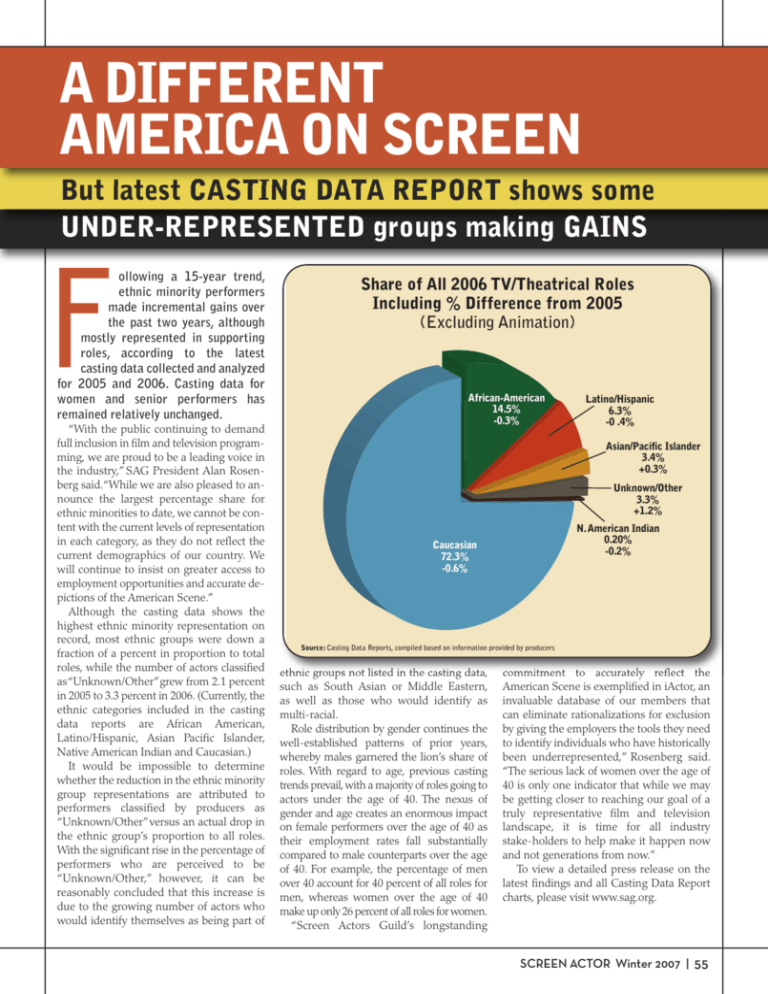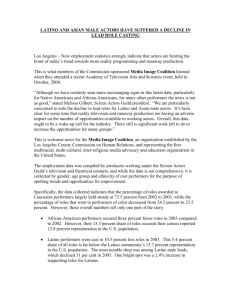a different america on screen - sag
advertisement

A DIFFERENT AMERICA ON SCREEN But latest CASTING DATA REPORT shows some UNDER-REPRESENTED groups making GAINS ollowing a 15-year trend, ethnic minority performers made incremental gains over the past two years, although mostly represented in supporting roles, according to the latest casting data collected and analyzed for 2005 and 2006. Casting data for women and senior performers has remained relatively unchanged. “With the public continuing to demand full inclusion in film and television programming, we are proud to be a leading voice in the industry,” SAG President Alan Rosenberg said.“While we are also pleased to announce the largest percentage share for ethnic minorities to date, we cannot be content with the current levels of representation in each category, as they do not reflect the current demographics of our country. We will continue to insist on greater access to employment opportunities and accurate depictions of the American Scene.” Although the casting data shows the highest ethnic minority representation on record, most ethnic groups were down a fraction of a percent in proportion to total roles, while the number of actors classified as“Unknown/Other”grew from 2.1 percent in 2005 to 3.3 percent in 2006. (Currently, the ethnic categories included in the casting data reports are African American, Latino/Hispanic, Asian Pacific Islander, Native American Indian and Caucasian.) It would be impossible to determine whether the reduction in the ethnic minority group representations are attributed to performers classified by producers as “Unknown/Other”versus an actual drop in the ethnic group’s proportion to all roles. With the significant rise in the percentage of performers who are perceived to be “Unknown/Other,” however, it can be reasonably concluded that this increase is due to the growing number of actors who would identify themselves as being part of Share of All 2006 TV/Theatrical Roles Including % Difference from 2005 (Excluding Animation) African-American 14.5% -0.3% Latino/Hispanic 6.3% -0 .4% Asian/Pacific Islander 3.4% +0.3% Unknown/Other 3.3% +1.2% N.American Indian 0.20% -0.2% Caucasian 72.3% -0.6% Source: Casting Data Reports, compiled based on information provided by producers ethnic groups not listed in the casting data, such as South Asian or Middle Eastern, as well as those who would identify as multi-racial. Role distribution by gender continues the well-established patterns of prior years, whereby males garnered the lion’s share of roles. With regard to age, previous casting trends prevail, with a majority of roles going to actors under the age of 40. The nexus of gender and age creates an enormous impact on female performers over the age of 40 as their employment rates fall substantially compared to male counterparts over the age of 40. For example, the percentage of men over 40 account for 40 percent of all roles for men, whereas women over the age of 40 make up only 26 percent of all roles for women. “Screen Actors Guild’s longstanding commitment to accurately reflect the American Scene is exemplified in iActor, an invaluable database of our members that can eliminate rationalizations for exclusion by giving the employers the tools they need to identify individuals who have historically been underrepresented,” Rosenberg said. “The serious lack of women over the age of 40 is only one indicator that while we may be getting closer to reaching our goal of a truly representative film and television landscape, it is time for all industry stake-holders to help make it happen now and not generations from now.” To view a detailed press release on the latest findings and all Casting Data Report charts, please visit www.sag.org. SCREEN ACTOR Winter 2007 | 55 “What are the Casting Data Reports?” Casting Data Compared to U.S. Census In an ongoing joint effort by Screen Actors Guild and producers to realistically portray “the American Scene,” producers who are signatory to the Guild’s television and theatrical contracts must submit hiring data of performers on all productions from theatrical feature films, theatrical low budget films, television episodic programs and television nonepisodic programs. Specifically, with the purpose to improve conditions for equal employment access and opportunities, hiring data based on gender, age, and race/ethnicity of performers are examined to determine hiring trends of our traditionally underemployed and disenfranchised membership. Beginning in 2004, the “Theatrical – Low Budget Presentations”section has been added to accommodate the reporting and analysis of low budget theatrical data, as the Guild determined the importance of tracking Low Budget and Modified Low Budget films since such film agreements contain Diversity in Casting incentives. 72.0% 58.6% 58.0% 2006 Casting Data 2006 Casting Data 54.8% 2000 U.S. Census 2000 U.S. Census 45.2% 40.0% 41.4% 26.0% MEN: Under 40 MEN: 40 and Over WOMEN: 40 and Over WOMEN: Under 40 Source:Casting Data Reports, compiled based on information provided by producers Share of All 2006 TV/Theatrical Roles (Excluding Animation) 76% Under 40 40 and Over 72% 68% “What Can I Do To Help Change the Face of Film and Television?” 60% 58% 57% 40% 40% 39% Log In and Be Seen! 29% 26% 23% All Male Roles Male Leads Male Supporting All Female Leads Female Leads Female Supporting Did you know that on iActor you can identify yourself to the casting community by what ethnicities/nationalities you can portray, what language skills you have and a variety of other talents and skills that will ensure that they know exactly who you are and what you can do. Show the industry just how diverse the SAG membership really is. Source: Casting Data Reports, compiled based on information provided by producers Join In and Be Seen! Please visit the Diversity section of the website and/or contact the Diversity Department to find out what the department and the committees are doing. Join your fellow Guild members as we advocate and educate on the local and national levels through these committees and task forces: Share of All 2006 TV/Theatrical Roles (Excluding Animation) 75.4% 72.3% 70.9% 15.4% 13.2% 2.5% 1% 0.1% es Lead Rol Caucasian African-American 14.5% 6.2% 4.0% 4.0% 6.5% 0.4% les g Ro Supportin Latino/Hispanic Asian/Pacific 6.3% 3.4% 3.3% 0.3% All Roles Unknown/Other N. American Indian • Ethnic Employment Opportunities Committee (EEOC) • Performers with Disabilities (PWD) Committee • Women’s Committee • Senior Performers Committee • President’s National Task Force on Spanish Language Media • Lesbian, Gay, Bisexual, Transgender (LGBT) Actors Committee • President’s National Task Force for American Indians • Hollywood Committee for American Indians Source: Casting Data Reports, compiled based on information provided by producers SCREEN ACTOR Winter 2007 | 57 “What Does the Affirmative Action/ Diversity Department Do for Me?” 6 We champion your civil rights… We educate… We lobby those who can hire you… We reach out to the community… We support your committees… We work tirelessly to advocate diverse hiring of under-represented groups, including minorities, women and the disabled, in the entertainment industry. The department offers career development programs, hiring statistics in our Casting Data Reports; support of national Committees for underrepresented groups… and much more. To find out more, visit the Diversity section of www.sag.org and take a look at the many ways we strive to achieve our goal of “casting the American Scene.” ■ Hollywood Rebecca Yee National Director/Senior EEO Counsel diversity@sag.org (323) 549-6644 New York Adam Moore Associate National Director nydiversity@sag.org (212) 827-1542 SCREEN ACTOR Winter 2007 | 59





